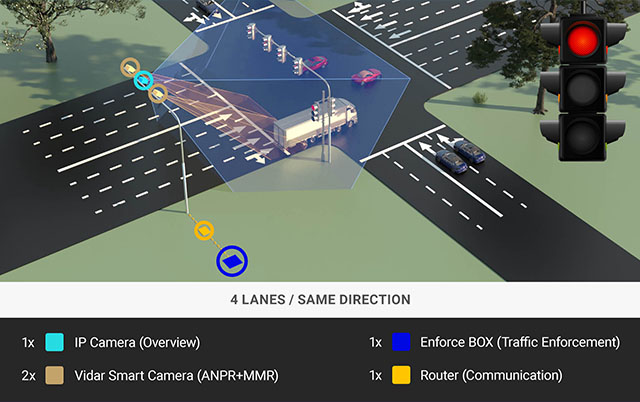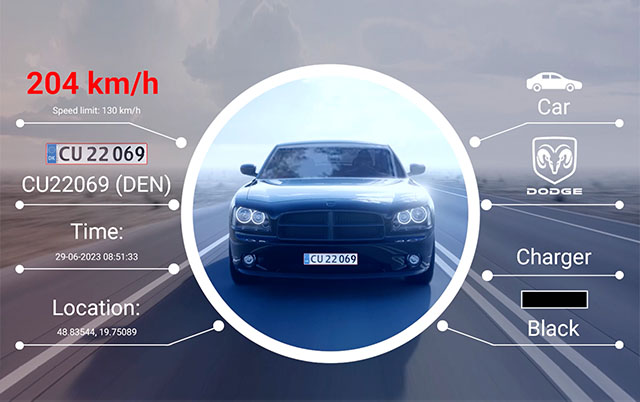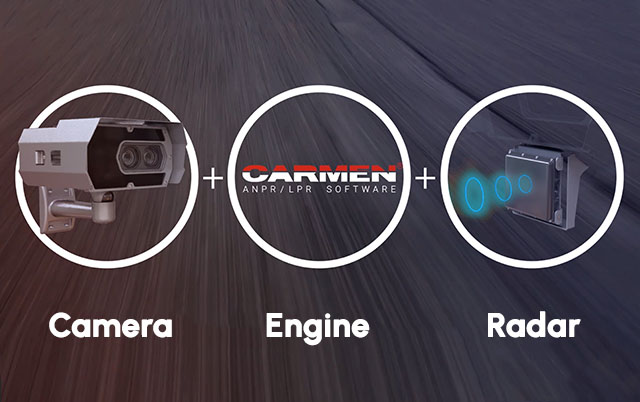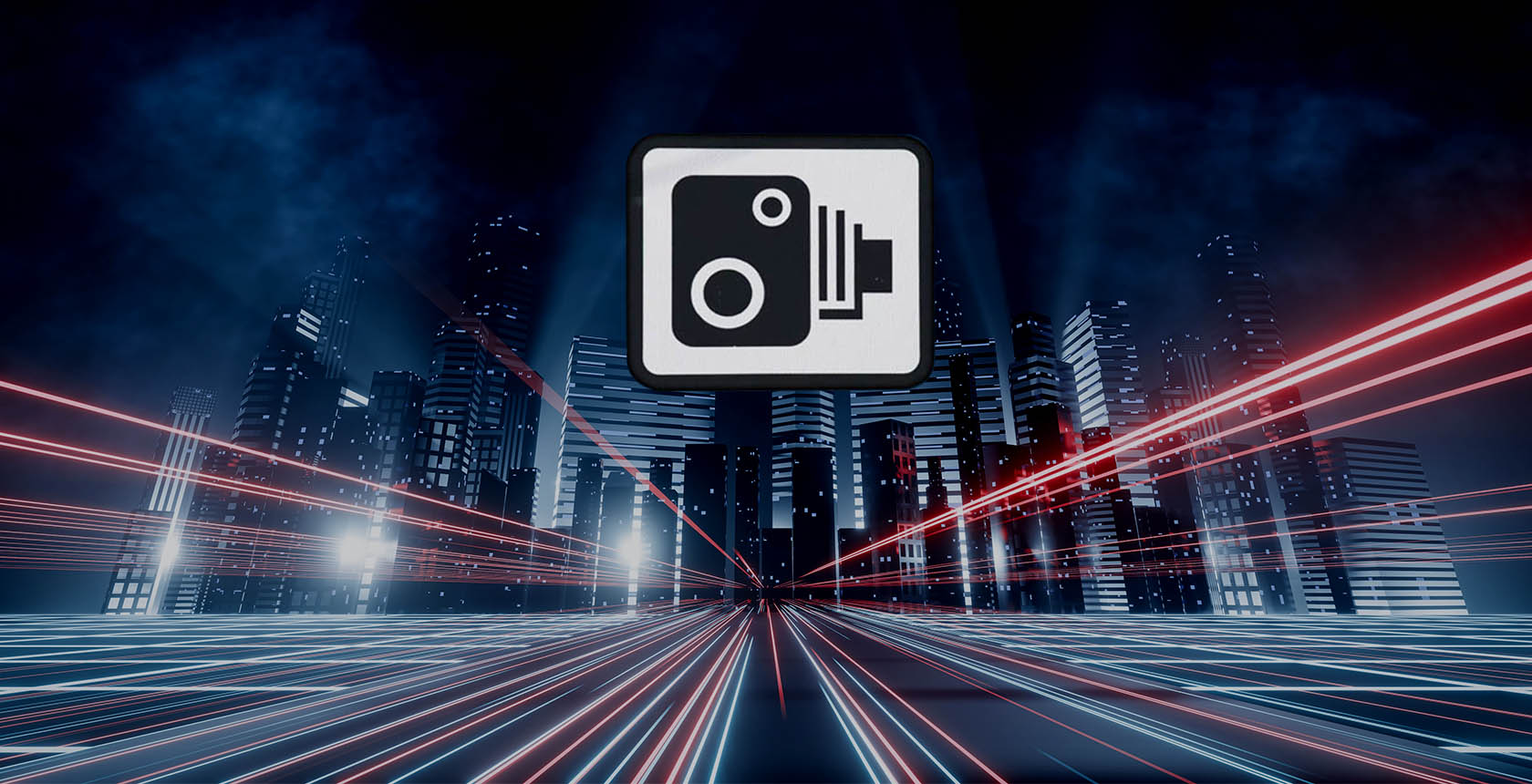In today’s fast-paced world, where the rush to save time often takes precedence, ensuring road safety and maintaining traffic order is more critical than ever. Speeding and traffic violations not only lead to accidents but also strain law enforcement resources. As a result, traffic enforcement cameras have become an indispensable asset in modern policing, transforming how traffic laws are upheld.
These up-to-date speed enforcement devices, powered by cutting-edge technology and artificial intelligence, have revolutionized how traffic laws are enforced. From identifying speed violations to enhancing overall police efficiency, traffic enforcement cameras are at the forefront of a safer, smarter approach to road safety.
In this blog post, we’ll explore the diverse components used in speed enforcement, the role of artificial intelligence in transforming these systems, and the tangible benefits these traffic law and speed enforcement cameras bring to society. Whether you’re a tech enthusiast or a policymaker looking for effective solutions, this comprehensive look into the world of traffic enforcement devices will showcase why they are essential for modern traffic management.
Speed Enforcement in Action: How These Devices Work to Keep Roads Safer
Speed detection cameras are indispensable tools in traffic law enforcement, helping to reduce accidents and ensure compliance with road regulations. Among these, Adaptive Recognition’s speed enforcement components stand out for their ability to detect, monitor, and record a wide range of traffic events, providing law enforcement agencies with the tools needed to improve road safety effectively. These devices use a combination of software and hardware triggers, carefully set up to automatically identify a wide range of traffic violations. While Adaptive Recognition provides the essential components for these systems, additional business logic can be added during integration to customize the system further, ensuring accurate violation detection and effective management of infractions.
Examples of Integrated Capabilities in Adaptive Recognition’s Speed Enforcement Components:
- Speed Limit Violations: Devices like the VIDAR Speed Detection Camera are equipped with a METAS-certified 4D speed enforcement radar, capable of tracking multiple vehicles simultaneously and capturing speeds up to 320 km/h (200 mph) across two lanes, regardless of whether the vehicles are approaching or moving away. This integration allows for precise and reliable speed measurement without the need for additional components. Additionally, the product includes ANPR (Automatic Number Plate Recognition), MMR (Make and Model Recognition), and ADR (Dangerous Goods Signs Recognition) software, ensuring clear and precise vehicle identification.
- Red Light Violations: Adaptive Recognition’s Enforce BOX can detect traffic light status without the need for embedded roadway sensors or direct integration with the traffic light controller. This feature enables automatic red-light enforcement, enhancing traffic law compliance.

- Other Violations: The Enforce BOX also supports the detection of various traffic violations, such as illegal turns or unauthorized lane usage, by analyzing data from connected cameras. This versatility aids in maintaining order and improving traffic flow.
- Seat Belt and Mobile Phone Usage: Some of Adaptive Recognition’s advanced cameras can detect unfastened seat belts and identify drivers using mobile phones, addressing safety risks associated with distracted driving and non-compliance with safety regulations.
While Adaptive Recognition’s devices come with robust, integrated capabilities for detecting a variety of traffic violations, additional customization can be implemented during installation to tailor the system to specific enforcement needs. This flexibility allows law enforcement agencies to effectively enforce traffic laws, enhancing road safety. By utilizing this technology, cities can ensure traffic law compliance, improve safety, and streamline enforcement, creating safer roads for all.
Boosting Police Efficiency: How Enforcement Components Simplify Law Enforcement Work
The use of advanced traffic monitoring technology significantly enhances the effectiveness of police work by automating many of the processes traditionally requiring manual effort. These systems operate with minimal setup and intervention, reducing the time officers need to spend managing data collection. With the use of Adaptive Recognition’s devices, the vehicle detection rate can reach 100%, ensuring that virtually every vehicle in the monitored area is recorded. This high level of automated traffic enforcement enables law enforcement to focus on more critical tasks while the enforcement system captures violations with accuracy.
Violations are stored in court-admissible event packages, ensuring secure and legally valid evidence. Adaptive Recognition’s advanced ANPR engine accurately reads complex license plates, including stacked characters and multiple plates at acute angles, even in challenging conditions. Additionally, this technology provides a complete data package for each violation, including images, license plate data, vehicle details (such as make, model, color, and class), GPS coordinates, and timestamps.

This comprehensive information supports investigations and allows police officers to assess incidents quickly. This enforcement system is also highly customizable, ensuring that it fits into a wide variety of legal environments and can be integrated with existing systems. With intelligent functions, the setup and operation of these systems are straightforward, making them a valuable tool for law enforcement agencies looking to improve both efficiency and accuracy.
Flexible Speed Enforcement Solutions: Tailored to Fit Every Need and Budget
With over 30 years of expertise in the field, Adaptive Recognition offers a comprehensive range of fixed, mobile, portable and auxiliary traffic monitoring and enforcement components that have been tested and proven in diverse scenarios and projects worldwide.
The stationary or fixed speeding cameras offer key functionalities, such as automatic recognition of license plates, nationality, vehicle make, model, color, class across one or multiple lanes, utilizing the Vidar ANPR camera.” Additionally, the radar-equipped speed cameras deliver speed measurements that are certifiable and metrologically approved in multiple countries, ensuring compliance with radar-enforced speed limits and enabling the calculation of a vehicle’s average speed over a defined section of road.
Adaptive Recognition’s intelligent enforcement cameras also feature advanced capabilities, including the ability to identify over 38,000 different license plate types. Depending on the business logic, these cameras can alert authorities when vehicles are carrying dangerous goods, providing an extra layer of security.
The components are capable of capturing vehicles instantly through both software- and hardware-based triggers, ensuring quick and accurate monitoring. Moreover, AR’s traffic enforcement cameras are designed to operate effectively under all weather conditions and lighting environments, making them reliable in even the most challenging circumstances. These features combine to provide a robust and versatile solution for traffic monitoring and speed limit enforcement.
The S1 portable speed cameras, equipped with high-precision laser units, offer exceptional performance in detecting speed violations from over 1 kilometer away. These cameras can monitor up to 3 lanes in both directions, ensuring comprehensive coverage. In addition to speed measurements, the S1 police speed camera automatically detects and documents other traffic violations, such as prohibited entry, illegal overtaking, and unauthorized use of service or bus lanes. It also contributes to event documentation by recording evidence, determining the vehicle’s country of origin, license plate, and category. Thanks to its specialized battery unit, it can operate continuously for up to 8 hours, functioning effectively both day and night.
The S1 system collects and processes data in real-time, sending it immediately to the control room or storing it in the device’s memory for later retrieval. This data can be easily synchronized with both national and international databases, enhancing its versatility. One of its standout features is its ability to alert officers if a wanted vehicle is approaching, streamlining law enforcement and helping to ensure that high-priority targets are identified quickly. The S1 speed camera, with its broad capabilities, provides an efficient and reliable solution for vehicle speed monitoring and enforcement in a variety of settings.
Carmen® Mobile is a powerful ANPR/ALPR Android mobile app designed for real-time automatic license plate recognition (ALPR/ANPR) on the go. This app enables the collection of data in real time, generating alerts based on wanted car lists, and sending the gathered information directly to any back-office server or Adaptive Recognition’s Globessey Data Server (GDS) for analysis. With an active 4G connection, Carmen® Mobile continues to collect images even when offline, ensuring continuous operation. The app stores images along with ANPR and make and model recognition (MMR) data, either on the device or within the GDS.
Carmen® Mobile is unique in its ability to accurately read license plates at high speeds and can be integrated with any existing applications, running seamlessly in the background. Additionally, it can form the backbone of complete traffic monitoring and enforcement systems, forwarding data to central databases that alert officers to relevant events in real time.
The Lynet mobile ANPR/ALPR camera, equipped with onboard ANPR and MMR, are ideal for patrols and identifying wanted vehicles. These ultra small cameras can be easily mounted on the rooftop/roof rack or behind the windshield of a police vehicle, scanning surrounding traffic to capture license plate information. With their fully weatherproof, heavy-duty housing, the cameras are built to withstand challenging environmental conditions, ensuring reliable performance in all situations. These cameras are an excellent tool for mobile, real-time traffic monitoring, and with the upcoming Lynet Speed, which will feature a built-in 4D radar, they will also enforce speed limits.
The Carmen® Box and Enforce Box by Adaptive Recognition serve as powerful auxiliary devices that complement existing enforcement systems, offering a cost-effective solution for law enforcement applications. These devices enhance traffic management and monitoring capabilities without the need to overhaul current infrastructure.
The Carmen® Box enables seamless ANPR integration with existing CCTV systems, adding advanced AI-powered features such as Automatic License Plate Recognition (ALPR/ANPR) and Make and Model Recognition (MMR). This box can process video streams from any compatible camera, making it an affordable option for improving vehicle tracking and incident documentation.
On the other hand, the Enforce Box provides a range of enforcement applications, such as red-light and stop violation detection, illegal U-turns, and emergency lane misuse. With support for 12 different enforcement scenarios, this device helps capture and document traffic violations accurately.
Both devices are designed to be scalable, allowing municipalities and law enforcement agencies to enhance their traffic surveillance systems without the need for extensive new camera installations. By adding intelligence and advanced analytics to existing cameras, these auxiliary devices offer a practical and efficient enforcement solution with photo-enforced speed limits, seamlessly integrating with current systems to enhance overall effectiveness.
AI’s Game-Changing Role in Speed Enforcement
Artificial intelligence (AI) is transforming speed enforcement by making it more accurate, efficient, and responsive. One significant advancement is real-time data analysis, where AI processes vast traffic data streams instantaneously to detect violations and respond faster. Machine learning models predict high-risk areas based on historical patterns, enabling dynamic deployment of speed cameras. AI also minimizes false positives, a common issue in traditional systems caused by environmental factors such as adverse weather or dense traffic. By employing advanced image and video analysis, AI ensures accurate identification of violations, including license plate recognition and vehicle classification.
In this context, Adaptive Recognition’s cameras harness AI-driven capabilities to identify violations with precision. They can also monitor additional behaviors, such as seat belt use and mobile phone distractions, encouraging safer driving habits. Visible enforcement tools like these cameras act as deterrents, motivating drivers to comply with traffic laws and promoting safer, more efficient road usage.
Looking ahead, AI’s role in speed enforcement will continue to evolve, allowing for even smarter, more adaptive systems. As technology advances, these systems will become better at predicting traffic patterns, improving road safety, and reducing accidents, ultimately benefiting both law enforcement agencies and the public by creating safer roadways for all.
The Multi-Dimensional Benefits of Speed Enforcement: Saving Lives, Money, and the Environment
Speed enforcement is often criticized as a revenue-generating mechanism, but its broader benefits are substantial. By reducing speed-related accidents, it lowers the economic burden of emergency services, medical care, and property damage. Compliance with speed limits also extends road lifespan, reducing maintenance costs.
Additionally, the development and maintenance of speed enforcement systems, including components like cameras, radars, and AI-powered software, create jobs in technology, manufacturing, and support services, boosting local economies.

Most importantly, speed enforcement saves lives. Speeding contributes significantly to road crashes, increasing stopping distances and collision severity. In 2021, speeding was involved in 29% of U.S. traffic fatalities, resulting in 12,330 deaths. Studies show speed cameras can reduce crashes by 19% and serious accidents by 21%, especially in high-risk areas like school zones and construction sites.
Speed enforcement also fosters safer driving habits, encouraging consistent speed limit adherence and smoother traffic flow. This behavioral shift not only reduces the likelihood of accidents but also improves the predictability of traffic flow, leading to smoother journeys and fewer instances of aggressive driving.
From a community’s perspective it helps reduce noise and air pollution, contributing to healthier, quieter communities. Slower, consistent speeds lower the strain on the environment, promoting cleaner air and quieter neighborhoods. In urban areas, this contributes to more livable spaces and healthier populations.
By holding all drivers to the same standards, it ensures fairness, builds trust, and supports safer, more sustainable road networks. These benefits collectively contribute to safer, more sustainable, and harmonious road networks, making speed enforcement a vital component of modern traffic management.
Global Approaches to Speed Enforcement: Innovations Shaping the Future of Road Safety
Speed enforcement strategies are evolving globally, shaped by the growing trends in innovative technologies and tailored to meet the unique needs of each country’s culture, laws, and traffic conditions. For example:
- In Germany, adaptive systems adjust speed limits on the Autobahn based on traffic, weather, and accident data.
- Sweden’s Vision Zero initiative integrates enforcement with urban planning to eliminate traffic fatalities, using cameras in high-risk areas and public awareness campaigns.
- Singapore combines speed enforcement with smart traffic management, where cameras interact with connected vehicles and infrastructure.
Emerging technologies, such as drones and speed limit enforced by aircraft, are also improving the reach and effectiveness of global enforcement strategies. Emerging technologies, such as drones and speed limits enforced by aircraft, are revolutionizing the global approach to speed enforcement by enabling real-time monitoring of high-risk areas and hard-to-reach zones. These innovations allow authorities to enforce speed limits across vast regions and improve the accuracy of violations detection, further enhancing the effectiveness of enforcement strategies.
Closing the Loop: How Advanced Speed Enforcement is Shaping Safer, Smarter Roads
In conclusion, traffic enforcement cameras are at the forefront of revolutionizing speed enforcement, enhancing police efficiency, and improving road safety across the globe. The integration of flexible solutions like mobile, fixed, portable, and auxiliary devices ensures that enforcement systems can meet the diverse needs of cities, municipalities, and law enforcement agencies, regardless of budget constraints.
With AI transforming speed enforcement by automating violations and reducing human error, these technologies empower law enforcement to make faster, more accurate decisions. The benefits of speed enforcement extend beyond road safety, contributing to environmental sustainability, economic savings, and more harmonious communities.
Global approaches are increasingly adopting innovative solutions, from AI-powered cameras to aircraft-enforced speed limits, which are pushing the boundaries of traditional enforcement systems. As technology continues to advance, we can expect even more effective, fair, and efficient traffic enforcement solutions that will keep our roads safer for everyone.


